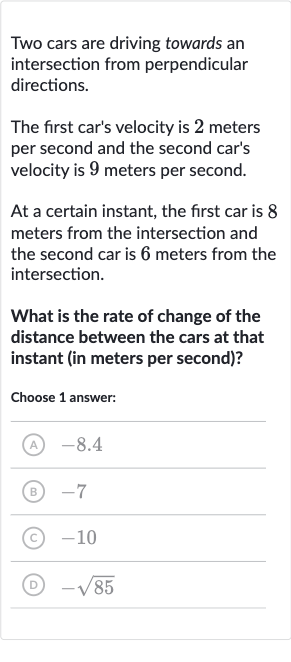AI tutor
Welcome to Bytelearn!
Let’s check out your problem:

Two cars are driving towards an intersection from perpendicular directions.The first car's velocity is meters per second and the second car's velocity is meters per second.At a certain instant, the first car is meters from the intersection and the second car is meters from the intersection.What is the rate of change of the distance between the cars at that instant (in meters per second)?Choose answer:(A) .(B) (C) (D)
Full solution
Q. Two cars are driving towards an intersection from perpendicular directions.The first car's velocity is meters per second and the second car's velocity is meters per second.At a certain instant, the first car is meters from the intersection and the second car is meters from the intersection.What is the rate of change of the distance between the cars at that instant (in meters per second)?Choose answer:(A) .(B) (C) (D)
- Initial Distance Calculation: First car's distance from intersection is meters, second car's distance is meters. We need to find the rate at which the distance between them is changing.
- Pythagoras' Theorem Application: Let's use Pythagoras' theorem to find the initial distance between the cars. .
- Calculation of Initial Distance: Calculating the initial distance: .
- Differentiation for Rate of Change: , so .
- Velocities of the Cars: Distance = meters. This is the initial distance between the cars.
- Substitution of Values: Now, let's differentiate the distance with respect to time to find the rate of change. If is the distance of the first car and is the distance of the second car from the intersection, then using the chain rule, .
- Rate of Change Calculation: The velocities of the cars are given as (since it's approaching the intersection, we take it as negative) and (also approaching, hence negative).
- Rate of Change Calculation: The velocities of the cars are given as (since it's approaching the intersection, we take it as negative) and (also approaching, hence negative).Substitute the values into the differentiation formula: .
- Rate of Change Calculation: The velocities of the cars are given as (since it's approaching the intersection, we take it as negative) and (also approaching, hence negative).Substitute the values into the differentiation formula: .Calculate the rate of change: .
